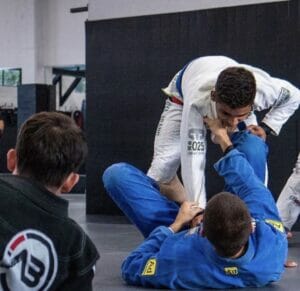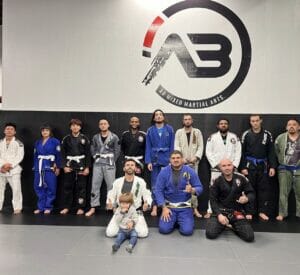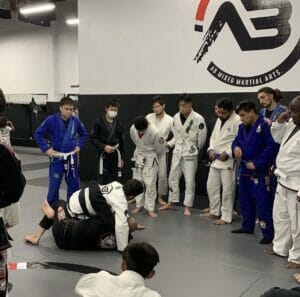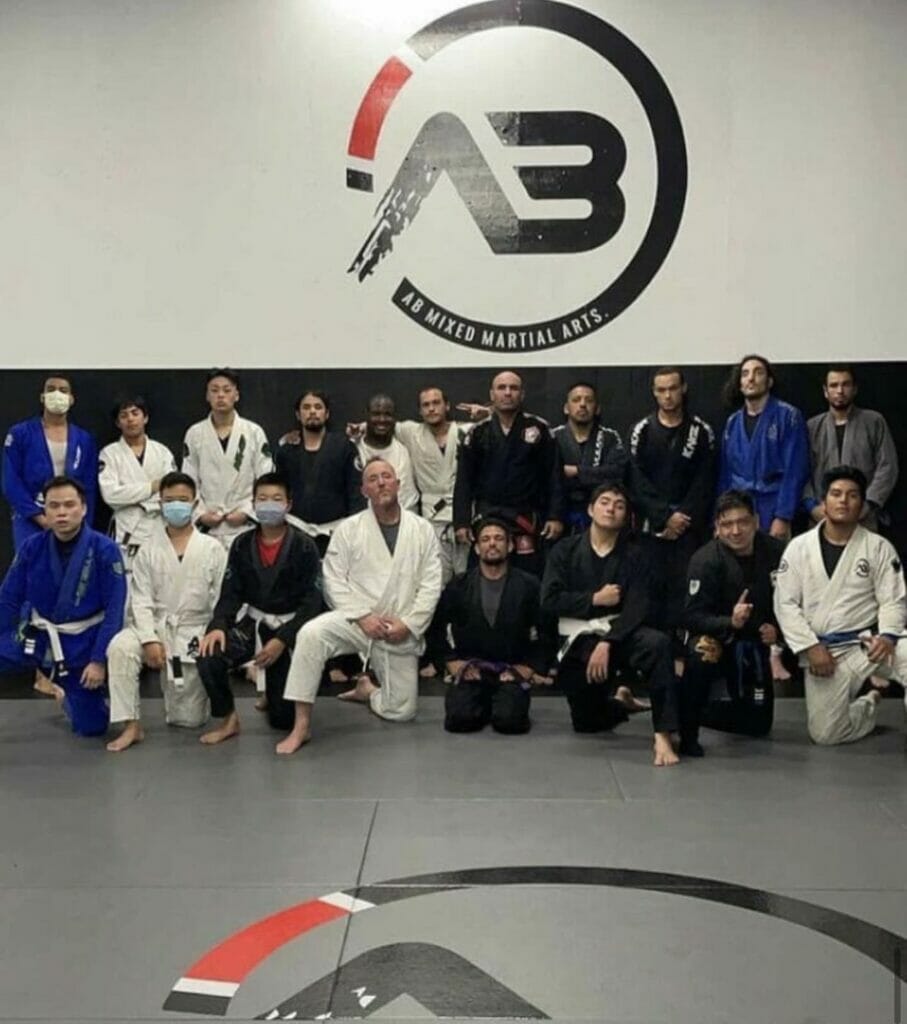Overview of Jujitsu and Brazilian Jiu-Jitsu

Jujitsu and Brazilian Jiu-Jitsu are martial arts specializing in grappling and ground fighting techniques. While the two skills share similarities, there are some key differences. Brazilian Jiu-Jitsu (BJJ) promotes that smaller, weaker individuals can effectively defend themselves against bigger, stronger attackers. Jujitsu and BJJ emphasize using leverage, proper technique, and taking the fight to the ground. These martial arts can be practiced for self-defense, sport grappling tournaments, or mixed martial arts (MMA) competitions. If you’re interested in learning Jujitsu or Brazilian Jiu-Jitsu, AB MMA offers BJJ classes taught by world-class instructors.
Jujitsu is a Japanese martial art that originated in feudal Japan and was used by the samurai warriors as self-defense on the battlefield. It focuses on using an opponent’s energy and movements against them, utilizing joint locks, throws, and strikes to neutralize an attacker. On the other hand, Brazilian Jiu-Jitsu is a modified version of traditional Jujitsu developed in Brazil by the Gracie family. It places a heavy emphasis on ground fighting and submission holds, allowing a smaller and weaker person to overcome a more extensive and stronger opponent through the efficient use of leverage and technique.
Training Methods in Jujitsu and Brazilian Jiu-Jitsu
Jujitsu and Brazilian Jiu Jitsu employ various training methods to develop skills and proficiency. Two essential components of training in these martial arts are drilling and sparring. Drilling involves repetitive practice of techniques to build muscle memory and improve execution. Through drilling, practitioners can refine their movements, become more fluid in their plans, and develop a deep understanding of the mechanics behind each move. By drilling specific techniques repeatedly, practitioners can ingrain these movements into their muscle memory, allowing them to execute them instinctively in real-life situations.
Sparring, on the other hand, allows practitioners to apply their skills in live scenarios, testing their techniques against resisting opponents. This live drilling helps develop the ability to adapt and apply techniques in real-time situations. Sparring sessions can range from light and controlled to full intensity, depending on the practitioner’s skill level and goals. It provides an opportunity to practice techniques against an opponent actively resisting, simulating the unpredictability and chaos of a real fight.
In addition to drilling and sparring, Jujitsu and Brazilian Jiu-Jitsu training often includes other conditioning exercises to improve strength, endurance, and flexibility. These exercises may include bodyweight, weightlifting, cardiovascular training, and stretching. By developing a solid and conditioned body, practitioners can perform techniques more effectively and reduce the risk of injury.
Principles and Philosophy of Jujitsu and Brazilian Jiu-Jitsu
Jujitsu and Brazilian Jiu-Jitsu are rooted in specific principles and philosophies. Both arts emphasize technical precision, leverage, and strategy. A fundamental principle in Brazilian Jiu-Jitsu is “position before submission,” which means establishing and maintaining a dominant position over an opponent before attempting a submission hold. This principle highlights the importance of control and patience in Jiu-Jitsu. By focusing on securing a superior place, practitioners can effectively neutralize an opponent’s attacks and set up their submissions.
Efficient use of energy is also emphasized in Jujitsu and Brazilian Jiu Jitsu, relying on technique and timing rather than relying solely on brute strength. These arts teach practitioners to conserve energy by using leverage and proper body mechanics to overcome larger and stronger opponents. A more petite person can effectively control and submit to a larger opponent using the appropriate technique at the right time.
These martial arts ‘ continuous learning and adaptation are essential as they constantly evolve with new techniques and strategies. Jujitsu and Brazilian Jiu-Jitsu practitioners are encouraged to experiment and explore different approaches to find the best. This continuous improvement mindset allows practitioners to adapt to different situations and opponents, making them well-rounded and versatile martial artists.
Standard Techniques and Exercises in Jujitsu and Brazilian Jiu-Jitsu
Jujitsu and Brazilian Jiu-Jitsu utilize various techniques to control and submit opponents, including joint locks and chokeholds. These techniques involve leveraging an opponent’s movements, applying pressure, and manipulating their body position [1, 4]. For example, in Jujitsu, practitioners learn techniques such as arm locks, leg locks, throws, and strikes. In Brazilian Jiu-Jitsu, practitioners focus more on ground fighting techniques, such as sweeps, guard passes, and submissions.
Jujitsu and Brazilian Jiu Jitsu exercise focus on improving grappling, ground fighting, and overall fitness. These exercises may include specific drills to enhance takedowns, submissions, and escapes. They may also include conditioning exercises to develop strength, endurance, and flexibility. For example, practitioners may perform activities such as bridging, shrimping, and hip escapes to build core strength and improve mobility on the ground. Grip fighting is also emphasized in these arts, as it plays a vital role in controlling opponents and setting up submissions. By practicing grip fighting exercises, practitioners can develop a firm grip and improve their ability to control opponents.
Tips for Effective Training in Jujitsu and Brazilian Jiu-Jitsu
Consistency and dedication are crucial to maximizing your Jujitsu and Brazilian Jiu-Jitsu training. Regular attendance and consistent practice outside class time will help you progress and improve your skills. Setting goals for yourself and tracking your progress to stay motivated and focused is essential.
Proper breathing techniques and mental preparation can enhance performance during training and competitions. By focusing on your breath and staying calm and focused, you can maintain clarity of thought and make better decisions in high-pressure situations. Mental preparation can also involve visualizing techniques and scenarios, which can help improve execution and reaction time.
Adaptability and flowing with your opponents’ movements can improve your skills and ability to react in different situations. Instead of trying to force techniques, it is essential to be flexible and adjust your strategies based on the specific circumstances of each fight. You can find openings and capitalize on your opponent’s mistakes by being adaptable.
Practice, patience, and persistence are essential for mastering these martial arts. Progress in Jujitsu and Brazilian Jiu-Jitsu takes time and effort. It is necessary to stay committed to your training and not get discouraged by setbacks. You will gradually improve and see results by consistently showing up and putting in the work.
Regular sparring and pressure testing techniques contribute to skill development and preparation for real-life situations. By applying techniques against resisting opponents, you can better understand their effectiveness and how they can be modified or adjusted in different scenarios. Sparring also helps develop your timing, reflexes, and ability to read and react to your opponent’s movements.
Jujitsu and Brazilian Jiu-Jitsu for Self-Defense and Sport
Jujitsu and Brazilian Jiu-Jitsu have practical applications in self-defense scenarios, allowing individuals to overcome larger and stronger opponents. These arts teach techniques that can be used to defend oneself in real-life situations, where the focus is on using minimal energy for maximum effect. A practitioner can effectively neutralize a threat without relying on strikes or brute force by learning to control an opponent and apply joint locks or chokeholds.
These martial arts are widely used in sport grappling tournaments and MMA competitions due to their effectiveness in ground fighting and submission grappling. In these competitions, practitioners can test their skills against opponents of similar skill levels and receive feedback on their techniques. The techniques learned in Jujitsu and Brazilian Jiu-Jitsu can be adapted for real-world self-defense situations, focusing on using minimal energy for maximum effect. Practitioners can effectively protect themselves in various confrontations by prioritizing defense and survival.
In conclusion, Jujitsu and Brazilian Jiu-Jitsu are martial arts that offer effective grappling and ground fighting techniques for self-defense and sport. These arts emphasize leverage, design, and strategy over brute strength. By incorporating drilling, sparring, and various training methods, practitioners can develop their skills and adapt to different situations. Whether you want to improve your self-defense capabilities or participate in sport grappling tournaments, Jujitsu and Brazilian Jiu Jitsu provide valuable training methods and principles to enhance your martial arts journey.





